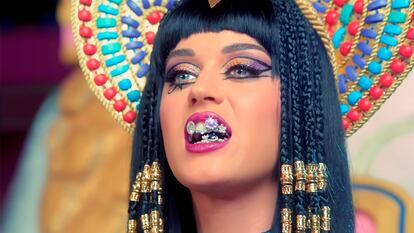From Rosalía’s butterfly to Katy Perry’s grill: The impact of jewelry on oral health
Experts warn it might look fashionable, but it can give you cavities and damage your gums

Dental jewelry seems to be everywhere. In addition to the shiny butterfly that adorns Rosalía’s teeth and Katy Perry’s million-dollar grill, it can be found in the mouths of celebrities like J Balvin, Madonna, Rihanna, Beyoncé and Miley Cyrus, as well as multiple non-famous people who flaunt their accessories (sometimes purchased online) on social media videos. But several oral health experts are warning of their potential risks.
Amanda Lorenzo Rodríguez, 25, works in a jewelry store. She has four crystals on her teeth, forming a butterfly that is similar to Rosalía’s. “Going on Pinterest and watching rapper videos, looking for urban fashion and ghetto references, I used to see them wearing grillz or gems,” she says. She got hers on sale and, even though she has only worn them for about two months, she sometimes forgets they are there. “When I look in the mirror and remember, it feels like I just got them,” she says.
According to periodontist Ana Echeverría Manau, the director of Cuida tus Encías (Take Care of your Gums) magazine, of the Spanish Society of Periodontics (SEPA), some jewels stick to the dental surface semi-permanently. That is the case of “small diamonds, or some designs in gold and silver.”
Then there are the metal crowns known as grillz, which are usually larger and cover one or more teeth. Óscar Castro Reino, president of the General Council of Dentists of Spain, explains that they are typically made of gold, silver or other precious materials, and are embedded with diamonds. There are several kinds: “Some are fixed and require prior preparation of the tooth, which includes wearing down the enamel and part of the dentin [a tissue under the enamel], and some are removable, which are made after taking a dental impression.” Users can also purchase a ready-made kind, which “adapts much worse to the tooth.”
A symbol of wealth and power
Grillz, also known as fronts, are not a new trend in the history of jewelry. “Actually, their roots can be traced back to 2,500 B.C., when Etruscan and Mayan women wore them as a symbol of wealth and power,” explains Jorge Sánchez Carrasco from Grillz Madriz, which specializes in custom-made pieces. However, it wasn’t until the 1980s that they became popular in the United States, “thanks to hip hop culture and artists.”
These jewels have evolved to become “something more than just fashion,” says Sánchez. “They are a unique type of jewelry, like a ring or a pendant.” The grill specialist explains that these accessories adapt to of each client’s teeth and are easy to remove and put back on – unless a client decides to have them fixed permanently. At Grillz Madriz, they began manufacturing this type of jewelry in 2017. Since then, they say, demand has only grown.
How are grillz created?
The manufacturing process of a grill takes approximately two weeks in this workshop, according to Jorge and Fabián Sánchez Carrasco, who are in charge of custom jewelry at Grillz Madriz. The first step is to create a plaster model that emulates the dental impression of the client, which will later be used to model the piece using either hand-sculpted wax or a 3D design. After the grillz are made with the chosen metal using a casting process, they are polished and carefully fitted to the mold. Finally, a jeweler sets the diamonds and customizes the piece.

There is a wide variety of designs. Some clients approach 3D jewelry designer Álvaro Urdiales Carabajal with a very clear idea of what they want, while others give him more creative freedom. The most common request is usually “a pair of dental pieces, either complete (caps that cover the entire tooth) or open face (which only cover the edges), or a combination of both.” But there are also “crazy” and original designs: from a broken heart to multiple upper and lower pieces with precious stones or a diastema (a piece that goes in the gap between two teeth).
Potential risks
When Lorenzo got a butterfly on her teeth, she did not care whether the crystals could cause any oral health problems; she just “really wanted it.” Afterwards, she was told to lead a normal life but avoid hot drinks for one hour, “just in case.” Echeverría explains that this type of jewelry, when it is this small, has few implications for dental health, although it does favor the accumulation of bacterial plaque. If they are larger, the periodontist warns, “they can cause wounds inside the lips and cheeks.”
The damage to the tooth structure depends in part on what method is used to fix the jewel, according to Néstor Montesdeoca García, associate head of the Oral and Maxillofacial Surgery Service at Hospital Universitario La Luz, in Madrid, Spain. “It can vary depending on the design, from a simple cementation on the enamel – the least damaging – to the encrustation, in which the dental surface must be eroded to fix the jewel,” he points out.
Isabel Giráldez, president of the Spanish Society of Conservative and Aesthetic Dentistry (SEOC) and medical director of the Albus Dental Studio Clinic, stresses that, sometimes, before placing larger dental jewels, they have to “thin the enamel, which can lead to an increase in tooth sensitivity.” For all these reasons, Montesdeoca advises against them. “In the end,” he says, “patients get tired, the trend passes and the tooth has to be repaired.”
Castro insists on the importance of knowing the possible risks of wearing grillz: “Fashion cannot be at odds with health.” Among the main problems associated with their use, he mentions an increased risk of cavities, interference with the bite and even pain and alteration in the temporomandibular joint (which connects the jaw to the side of the head). And, in some cases, “allergies to the materials have also been described.”
Grillz can also cause abrasion of the teeth that border them, according to Juan Carlos Pérez Varela, the president of the Spanish Orthodontic Society (SEDO) and another critic of “this kind of trends.” In addition, “their prolonged use can discolor or stain the teeth, depending on the material they are made of,” and if they are not correctly fitted, “they can cause trauma, fractures and even problems such as gingivitis, periodontal disease or gum recession.” For this reason, Castro advises opting for a piece that is tailored to the specific user, instead of a generic one.
Despite the warnings from scientific societies and experts, Grillz Madriz states that custom grillz are “a safe aesthetic option, as long as they are used correctly.” Jorge Sánchez points out that they must be done by a professional and that those who wear them have to follow some recommendations, such as not eating or sleeping with them, in addition to having good hygiene and keeping them clean to avoid the accumulation of dirt and bacteria.
Sign up for our weekly newsletter to get more English-language news coverage from EL PAÍS USA Edition
Tu suscripción se está usando en otro dispositivo
¿Quieres añadir otro usuario a tu suscripción?
Si continúas leyendo en este dispositivo, no se podrá leer en el otro.
FlechaTu suscripción se está usando en otro dispositivo y solo puedes acceder a EL PAÍS desde un dispositivo a la vez.
Si quieres compartir tu cuenta, cambia tu suscripción a la modalidad Premium, así podrás añadir otro usuario. Cada uno accederá con su propia cuenta de email, lo que os permitirá personalizar vuestra experiencia en EL PAÍS.
¿Tienes una suscripción de empresa? Accede aquí para contratar más cuentas.
En el caso de no saber quién está usando tu cuenta, te recomendamos cambiar tu contraseña aquí.
Si decides continuar compartiendo tu cuenta, este mensaje se mostrará en tu dispositivo y en el de la otra persona que está usando tu cuenta de forma indefinida, afectando a tu experiencia de lectura. Puedes consultar aquí los términos y condiciones de la suscripción digital.
More information
Archived In
Últimas noticias
Maduro pleads not guilty before the federal court in New York: ‘I am still the president of Venezuela’
A new test can detect Alzheimer’s from a finger prick
UN team enters Sudanese city of El Fasher after paramilitary massacre: ‘It’s like a ghost town’
A recipe for resistance: Indigenous peoples politicize their struggles from the kitchen
Most viewed
- Gilles Lipovetsky: ‘If you want to live better and fall in love, take Prozac, don’t look to philosophy’
- Alain Aspect, Nobel laureate in physics: ‘Einstein was so smart that he would have had to recognize quantum entanglement’
- Alvin Hellerstein, a 92-year-old judge appointed by Bill Clinton, to preside over Maduro’s trial in New York
- Why oil has been at the center of Venezuela-US conflicts for decades
- Maduro’s downfall puts China’s relationship with Venezuela to the test











































